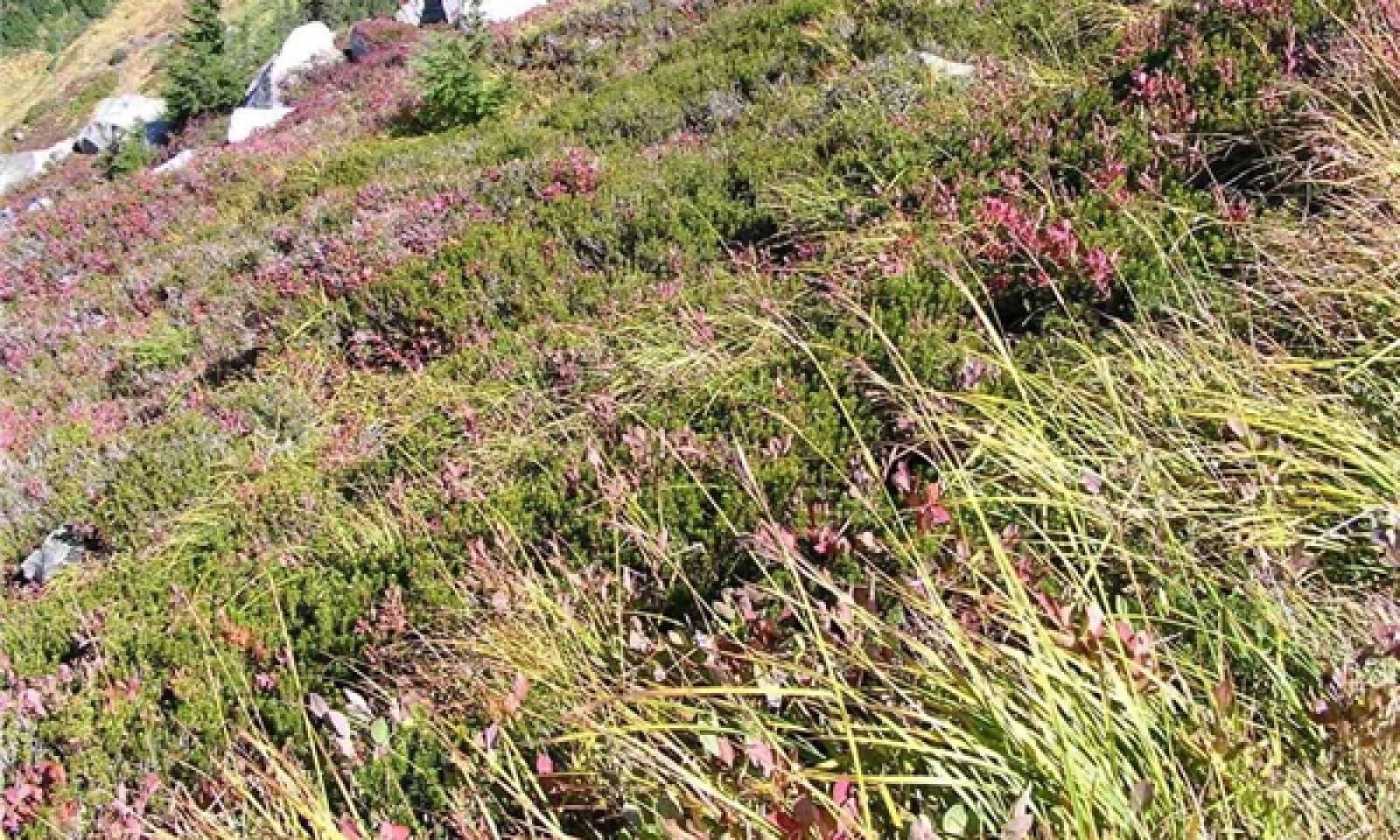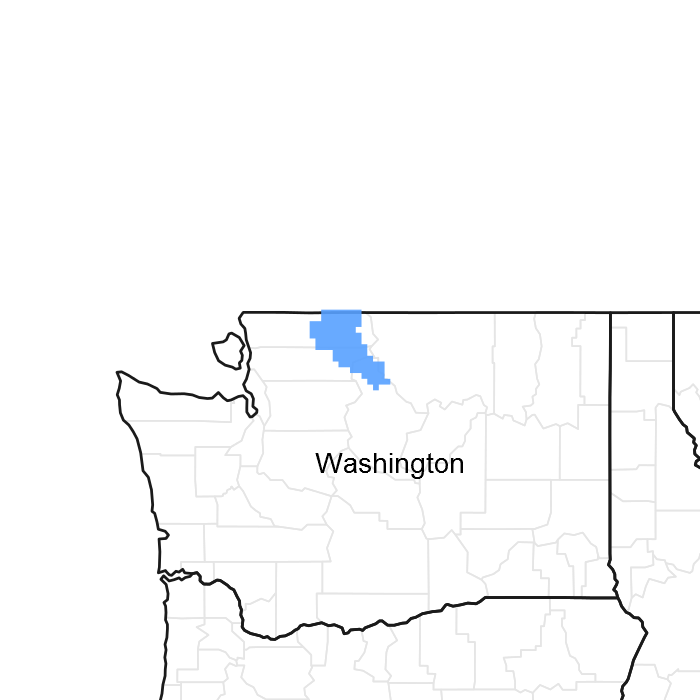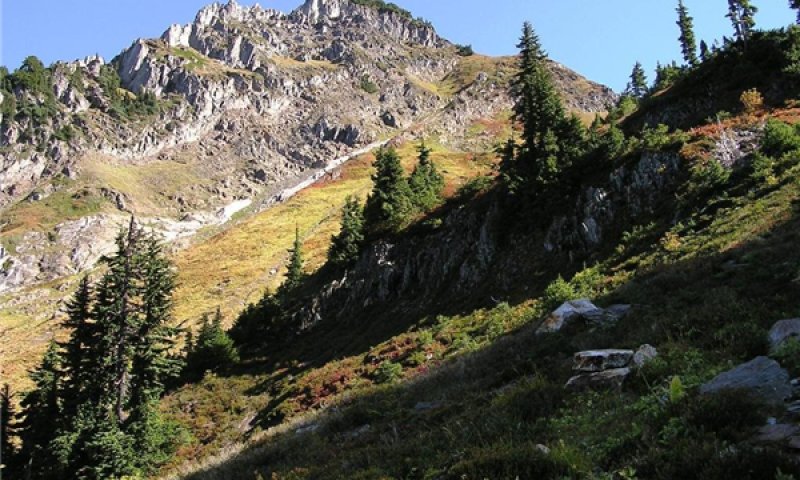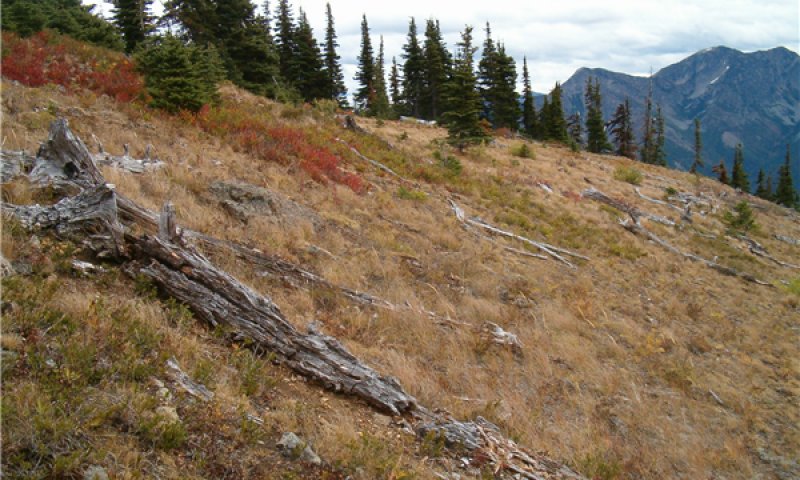

Natural Resources
Conservation Service
Ecological site R003XN502WA
Subalpine Parkland - Minor Natural Soil Disturbance
Last updated: 5/10/2024
Accessed: 12/22/2024
General information
Provisional. A provisional ecological site description has undergone quality control and quality assurance review. It contains a working state and transition model and enough information to identify the ecological site.

Figure 1. Mapped extent
Areas shown in blue indicate the maximum mapped extent of this ecological site. Other ecological sites likely occur within the highlighted areas. It is also possible for this ecological site to occur outside of highlighted areas if detailed soil survey has not been completed or recently updated.
Classification relationships
This ecological site is related to the following National Park Service Plant Alliance: Vaccinium (caespitosum, membranaceum, scoparium) Dwarf-shrubland
Associated sites
| F003XN925WA |
High Cryic/Udic Coniferous Can be found adjacent to this ecological site. |
|---|---|
| F003XN926WA |
Cryic/Udic Active Natural Disturbance Can be found adjacent to this ecological site. |
| R003XN512WA |
Subalpine Parkland - Active Natural Soil Disturbance Can be found adjacent to this ecological site. |
Table 1. Dominant plant species
| Tree |
Not specified |
|---|---|
| Shrub |
Not specified |
| Herbaceous |
Not specified |
Physiographic features
This native plant community occurs across many landscape positions at higher elevations of the North Cascades. This site occupies the high cryic/udic soil temperature/moisture regime and occurs on the more stable subalpine landscape positions of ridges, passes, cirque basins, and bedrock benches on valley walls which are subject to infrequent and low intensity natural soil disturbances.
This site, where mapped, ranged from 2950 to 7000 feet in elevation. The table below refers to the representative elevations of this site.
This ecological site has only been mapped within the boundary of the North Cascades National Park Complex.
Table 2. Representative physiographic features
| Landforms |
(1)
Ridge
(2) Mountain slope (3) Valley side |
|---|---|
| Flooding frequency | None |
| Elevation | 1,158 – 1,829 m |
| Slope | 0 – 90% |
Climatic features
This ecological site receives most of its annual precipitation from October to April in the form of snow that will commonly persist into early summer. In the first table below, the mean annual precipitation range for this ecological site is provided. In the second table, the minimum and maximum monthly values for precipitation and air temperature are listed for all areas where this ecological site has been assigned to soil delineations. The mean annual precipitation ranges from 80 to 115 inches (2023 to 2921 mm) and the mean annual temperature ranges from 31 to 47 degrees Fahrenheit (-0.5 to 8.3 degrees C). Generally this site occupies areas with cool dry summers and cold wet winters.
Precipitation and temperature data from: PRISM Climate Group, Oregon State University, http://prism.oregonstate.edu, created 4 Feb 2004. Information from the Ross Dam weather station was used by the PRISM Climate Group to generate climate data for the North Cascades region.
Table 3. Representative climatic features
| Frost-free period (average) | 60 days |
|---|---|
| Freeze-free period (average) | 90 days |
| Precipitation total (average) | 2,921 mm |
Figure 2. Monthly precipitation range
Figure 3. Monthly average minimum and maximum temperature
Influencing water features
This ecological site is not influenced by wetland or riparian water features.
Soil features
Applicable Soils: Arriva and Doubtful
The soils that support this native plant community occur in the high cryic soil temperature regime and udic soil moisture regime. For the purposes of the soil inventory, the cryic zone was divided into several zones to distinguish soil and/or climatic differences between the lower elevation west side zone (low cryic/udic west), the higher elevation crest zone (high cryic/udic), and lower elevation east side zone (low cryic/udic east). These soils are well drained and soil depth ranges from moderately deep to very deep. Generally these soils have a mantle of material with significant volcanic ash influence overlying glacial till or colluvium. The upper mantle is characterized by a low bulk density and high water holding capacity. Soil moisture is not a limiting factor to plant growth on these soils owing to abundance of precipitation and the inherent water holding properties of soils influenced by volcanic ash. Cold soil temperatures however, especially on more northerly aspects, may be a limiting factor to plant establishment and growth. Soils of the high cryic zone typically receive the most precipitation of all the ecological sites. Under this rangeland ecological site and in soils with significant volcanic ash influence and landscape stability (i.e. geologic time), pedogenic weathering produces well developed Andisols with thick umbric horizons and bright subsurface colors that can qualify as spodic horizon materials. Weak expression of albic soil horizons can sometimes be seen in soils of this zone. In many instances, the soils of this ecological site will display buried soil horizons as the strata from repeated volcanic ash deposits are not disturbed by tree tip activity.
Table 4. Representative soil features
| Surface texture |
(1) Ashy fine sandy loam (2) Ashy sandy loam |
|---|---|
| Family particle size |
(1) Loamy |
| Drainage class | Well drained |
| Permeability class | Moderate to very rapid |
| Soil depth | 51 cm |
| Surface fragment cover <=3" | 0 – 10% |
| Surface fragment cover >3" | 0 – 10% |
| Available water capacity (0-101.6cm) |
8.89 – 29.85 cm |
| Soil reaction (1:1 water) (0-101.6cm) |
4 – 6.5 |
| Subsurface fragment volume <=3" (Depth not specified) |
5 – 60% |
| Subsurface fragment volume >3" (Depth not specified) |
5 – 60% |
Ecological dynamics
These sites occur in the non-forested areas of the mid- and high elevation vegetated zones of the Cascade Mountains. Often these sites are on stable leeward slopes where the snow drifts deeper and persists longer into the spring and summer than on more exposed slopes. This pattern provides for more soil moisture to plants during the growing season, and more insulating protection for canopy branches during inclement weather. Also, these areas are less subject to frequent or habitual natural disturbances such as avalanches or soil movement. The lack of frequent natural soil disturbances, and the protection and moisture provided by the drifted snowpack results in a mosaic typically characterized by later seral stage vegetative communities. Historically, fire was an important disturbance factor in these communities, suppressing the heathers and favoring the production of huckleberries. If a very long interval occurs without disturbance, soil surface conditions can become protected enough to allow the establishment of conifers such as subalpine fir (Abies lasiocarpa). Disturbances will tend to reverse this progression, with the severity of disturbance dictating the effect on the species composition of the resulting community. Unless the disturbance is widespread, the plant communities will occur in a complex pattern that is related to variations in substrate, soil moisture conditions, duration of snowpack, and location and severity of disturbance. Smaller-scale disturbances such as tree tipping (bioturbation) or freeze-thaw cycles (cryoturbation), earthquakes, or movement of soils caused by water, either through saturation or movement of snow and ice will tend to remove vegetation from the site, with the severity of disturbance dictating the effect on the species composition of the resulting community. While the Reference community may be the most common community, it is likely that all Community Phases will occur intermingled in relatively close proximity on the site at any given time, and that over time the locations of each Phase will change depending on the disturbance pattern, recurrence and intensity. The reference community vegetation is characterized by a predominance of low-growing shrubs.
State and transition model

Figure 4. State and Transition Model
More interactive model formats are also available.
View Interactive Models
More interactive model formats are also available.
View Interactive Models
Click on state and transition labels to scroll to the respective text
Ecosystem states
State 1 submodel, plant communities
State 1
Reference State
White mountainheather (Cassiope mertensiana) - pink mountainheather (Phyllodoce empetriformis) heather communities are widespread in alpine and upper subalpine environments, and may extend into the lower subalpine but the habitat changes with elevation. At higher elevations in the alpine zone, the communities occupy relatively early-snowmelt sites and are slightly snow-avoiding. At lower elevations in the upper subalpine zone, the communities occupy sites where snow melts relatively late and they are moderately snow-avoiding. In the lower subalpine and in avalanche tracks extending into the forested zones, heather communities occur on benches and basins where snow melts late and growing conditions resemble those at higher elevations. Pink mountainheather - Cascade huckleberry (Vaccinium deliciosum) communities may also include dwarfed mountain hemlock (Tsuga mertensiana), prostrate Alaska cedar (Callitropsis nootkatensis), and scattered black huckleberry (Vaccinium membranaceum), especially in transitions to krummholz or tree islands. On late snow melt, wetter, peaty substrates, partridgefoot (Luetkea pectinata) and showy sedge (Carex spectabilis) are common associates.
Community 1.1
Low shrublands

Figure 5. Reference Community
This community is characterized by low-growing shrubs whose branches will typically be protected by drifting winter snows from dessication and wind-scouring. Common plants present on the site include black huckleberry (Vaccinium membranaceum), pink mountainheather (Phyllodoce empetriformis), white mountainheather (Cassiope mertensiana), and Cascade huckleberry (Vaccinium deliciosum) with scattered grasses such as blue wildrye (Elymus glaucus) and greenleaf fescue (Festuca viridula) and scattered forbs such as common yarrow (Achillea millefolium) and western pearly everlasting (Anaphalis margaritacea).
Figure 6. Annual production by plant type (representative values) or group (midpoint values)
Table 5. Ground cover
| Tree foliar cover | 0-5% |
|---|---|
| Shrub/vine/liana foliar cover | 20-100% |
| Grass/grasslike foliar cover | 10-30% |
| Forb foliar cover | 5-20% |
| Non-vascular plants | 0-35% |
| Biological crusts | 0% |
| Litter | 5-70% |
| Surface fragments >0.25" and <=3" | 0-10% |
| Surface fragments >3" | 0-10% |
| Bedrock | 0-10% |
| Water | 0% |
| Bare ground | 5-15% |
Community 1.2
Tree islands

Figure 7. Community Phase 1.2
If a very long interval occurs without disturbance, soil surface conditions can become protected enough to allow the establishment of conifers such as subalpine fir (Abies lasiocarpa) and mountain hemlock (Tsuga mertensiana). Understory plants commonly found in this phase include black huckleberry(Vaccinium membranaceum), pink mountainheather (Phyllodoce empetriformis), white mountainheather (Cassiope mertensiana), and Cascade huckleberry (Vaccinium deliciosum).
Community 1.3
Bare soil/rock
In Community Phase 1.3, the majority of vegetation has been removed through an intense disturbance such as an avalanche or mass movement and the site is effectively bare of vegetation. As the site recovers, Community Phase 1.4 will redevelop here during a transition interval, until soil surface conditions are improved enough to allow for re-establishment of the Reference low shrub community. Species such as greenleaf fescue (Festuca viridula), showy sedge (Carex spectabilis), partridgefoot (Luetkea pectinata) and subalpine lupine (Lupinus arcticus ssp. subalpinus) will gradually colonize this Community Phase.
Community 1.4
Grass/Forb Meadow

Figure 8. Community Phase 1.4
Vegetation is characterized by a predominance of forbs and grasses and grasslike plants. Common plants present on the site include subalpine lupine (Lupinus arcticus ssp. subalpinus), false hellebore (Veratrum viride), Sitka valerian(Valeriana sitchensis), showy sedge (Carex spectabilis), alpine bistort (Polygonum bistortoides), partridgefoot (Luetkea pectinata), avalanche lily (Erythronium montanum), and woolly pussytoes (Antennaria lanata).
Pathway 1.1A
Community 1.1 to 1.2


This pathway represents an extreme disturbance such as an avalanche, landslide or slower forms of mass movement which removes the majority of vegetation from the site.
Pathway 1.1B
Community 1.1 to 1.2


This pathway represents an ongoing lack of disturbance which favors the establishment of pockets of trees.
Pathway 1.2B
Community 1.2 to 1.1


This pathway represents disturbance which is significant enough to destroy trees but not flexible, low-growing shrubs which survive mainly due to stem flexibility.
Pathway 1.2A
Community 1.2 to 1.3
This pathway represents an extreme disturbance such as an avalanche, landslide or slower forms of mass movement which removes the majority of vegetation from the site.
Pathway 1.3A
Community 1.3 to 1.4
This pathway represents a lack of further major disturbance.
Pathway 1.4A
Community 1.4 to 1.1


This pathway represents a lack of further major disturbance.
Pathway 1.4B
Community 1.4 to 1.3
This pathway represents an extreme disturbance such as an avalanche, landslide or slower forms of mass movement which removes the majority of vegetation from the site.
Additional community tables
Table 6. Community 1.1 plant community composition
| Group | Common name | Symbol | Scientific name | Annual production (kg/hectare) | Foliar cover (%) | |
|---|---|---|---|---|---|---|
|
Shrub/Vine
|
||||||
| 1 | – | |||||
| western moss heather | CAME7 | Cassiope mertensiana | – | 0 | ||
| pink mountainheath | PHEM | Phyllodoce empetriformis | – | 0 | ||
| Sitka mountain ash | SOSIS2 | Sorbus sitchensis var. sitchensis | – | 0 | ||
| Cascade bilberry | VADE | Vaccinium deliciosum | – | 0 | ||
| thinleaf huckleberry | VAME | Vaccinium membranaceum | – | 0 | ||
|
Grass/Grasslike
|
||||||
| 1 | – | |||||
| showy sedge | CASP5 | Carex spectabilis | – | 0 | ||
| blue wildrye | ELGL | Elymus glaucus | – | 0 | ||
| greenleaf fescue | FEVI | Festuca viridula | – | 0 | ||
| Parry's rush | JUPA | Juncus parryi | – | 0 | ||
| smooth woodrush | LUGL2 | Luzula glabrata | – | 0 | ||
|
Forb
|
||||||
| 1 | – | |||||
| common yarrow | ACMI2 | Achillea millefolium | – | 0 | ||
| Drummond's anemone | ANDR | Anemone drummondii | – | 0 | ||
| woolly pussytoes | ANLA3 | Antennaria lanata | – | 0 | ||
| western pearly everlasting | ANMA | Anaphalis margaritacea | – | 0 | ||
| broadleaf arnica | ARLA8 | Arnica latifolia | – | 0 | ||
| edible thistle | CIED | Cirsium edule | – | 0 | ||
| subalpine fleabane | ERPE3 | Erigeron peregrinus | – | 0 | ||
| Gray's licorice-root | LIGR | Ligusticum grayi | – | 0 | ||
| subalpine lupine | LUARS2 | Lupinus arcticus ssp. subalpinus | – | 0 | ||
| partridgefoot | LUPE | Luetkea pectinata | – | 0 | ||
| spreading phlox | PHDI3 | Phlox diffusa | – | 0 | ||
| American bistort | POBI6 | Polygonum bistortoides | – | 0 | ||
| high mountain cinquefoil | POFL3 | Potentilla flabellifolia | – | 0 | ||
| white pasqueflower | PUOC | Pulsatilla occidentalis | – | 0 | ||
| arrowleaf ragwort | SETR | Senecio triangularis | – | 0 | ||
| Sitka valerian | VASI | Valeriana sitchensis | – | 0 | ||
| Cusick's speedwell | VECU | Veronica cusickii | – | 0 | ||
| green false hellebore | VEVI | Veratrum viride | – | 0 | ||
|
Tree
|
||||||
| 4 | – | |||||
| subalpine fir | ABLA | Abies lasiocarpa | – | 0 | ||
| whitebark pine | PIAL | Pinus albicaulis | – | 0 | ||
| mountain hemlock | TSME | Tsuga mertensiana | – | 0 | ||
Table 7. Community 1.2 plant community composition
| Group | Common name | Symbol | Scientific name | Annual production (kg/hectare) | Foliar cover (%) |
|---|
Interpretations
Supporting information
Inventory data references
Type Locality Plot ID: 06-CAB-020
Type locality
| Location 1: Chelan County, WA | |
|---|---|
| Township/Range/Section | T34N R13E S1 |
| UTM zone | N |
| UTM northing | 5369977.01 |
| UTM easting | 643396.569 |
| Latitude | 48° 28′ 0″ |
| Longitude | 121° 3′ 36″ |
Other references
Billings, W.D. 1973. Arctic and Alpine Vegetations: Similarities, Differences, and Susceptibility to Disturbance. BioScience, Vol. 23, No. 12 (Dec., 1973), pp. 697-704.
Billings, W.D. 1987. Constraints to Plant Growth, Reproduction, and Establishment in Arctic Environments. Arctic and Alpine Research, Vol. 19, No. 4, Restoration and Vegetation Succession in Circumpolar Lands: Seventh Conference of the Comité Arctique International (Nov., 1987), pp.357-365
Billings, W.D. and Bliss L.C. 1959. An Alpine Snowbank Environment and Its Effects on Vegetation, Plant Development, and Productivity. Ecology, Vol. 40, No. 3 (Jul., 1959), pp. 388-397.
Canaday, B.B. and Fonda, R.W. 1974. The Influence of Subalpine Snowbanks on Vegetation Pattern, Production, and Phenology. Bulletin of the Torrey Botanical Club, Vol. 101, No. 6 (Nov. - Dec., 1974), pp. 340-350
Crawford, R. C., C. B. Chappell, C. C. Thompson, and F. J. Rocchio. 2009. Vegetation classification of Mount Rainier, North Cascades, and Olympic National Parks. Natural Resource Technical Report NPS/NCCN/NRTR—2009/211. National Park Service, Fort Collins, Colorado. 58 pages.
Douglas, G.W. and Bliss L.C. 1977. Alpine and High Subalpine Plant Communities of the North Cascades Range, Washington and British Columbia. Ecological Monographs, Vol. 47, No. 2 (Spring, 1977), pp. 113-150.
Kuramoto, R.T. and Bliss L.C. 1970. Ecology of Subalpine Meadows in the Olympic Mountains, Washington. Ecological Monographs, Vol. 40, No. 3 (Summer, 1970), pp. 317-347.
Contributors
Martha Chaney
Marty Chaney
Approval
Kirt Walstad, 5/10/2024
Rangeland health reference sheet
Interpreting Indicators of Rangeland Health is a qualitative assessment protocol used to determine ecosystem condition based on benchmark characteristics described in the Reference Sheet. A suite of 17 (or more) indicators are typically considered in an assessment. The ecological site(s) representative of an assessment location must be known prior to applying the protocol and must be verified based on soils and climate. Current plant community cannot be used to identify the ecological site.
| Author(s)/participant(s) | |
|---|---|
| Contact for lead author | |
| Date | 12/22/2024 |
| Approved by | Kirt Walstad |
| Approval date | |
| Composition (Indicators 10 and 12) based on | Annual Production |
Indicators
-
Number and extent of rills:
-
Presence of water flow patterns:
-
Number and height of erosional pedestals or terracettes:
-
Bare ground from Ecological Site Description or other studies (rock, litter, lichen, moss, plant canopy are not bare ground):
-
Number of gullies and erosion associated with gullies:
-
Extent of wind scoured, blowouts and/or depositional areas:
-
Amount of litter movement (describe size and distance expected to travel):
-
Soil surface (top few mm) resistance to erosion (stability values are averages - most sites will show a range of values):
-
Soil surface structure and SOM content (include type of structure and A-horizon color and thickness):
-
Effect of community phase composition (relative proportion of different functional groups) and spatial distribution on infiltration and runoff:
-
Presence and thickness of compaction layer (usually none; describe soil profile features which may be mistaken for compaction on this site):
-
Functional/Structural Groups (list in order of descending dominance by above-ground annual-production or live foliar cover using symbols: >>, >, = to indicate much greater than, greater than, and equal to):
Dominant:
Sub-dominant:
Other:
Additional:
-
Amount of plant mortality and decadence (include which functional groups are expected to show mortality or decadence):
-
Average percent litter cover (%) and depth ( in):
-
Expected annual annual-production (this is TOTAL above-ground annual-production, not just forage annual-production):
-
Potential invasive (including noxious) species (native and non-native). List species which BOTH characterize degraded states and have the potential to become a dominant or co-dominant species on the ecological site if their future establishment and growth is not actively controlled by management interventions. Species that become dominant for only one to several years (e.g., short-term response to drought or wildfire) are not invasive plants. Note that unlike other indicators, we are describing what is NOT expected in the reference state for the ecological site:
-
Perennial plant reproductive capability:
Print Options
Sections
Font
Other
The Ecosystem Dynamics Interpretive Tool is an information system framework developed by the USDA-ARS Jornada Experimental Range, USDA Natural Resources Conservation Service, and New Mexico State University.
Click on box and path labels to scroll to the respective text.